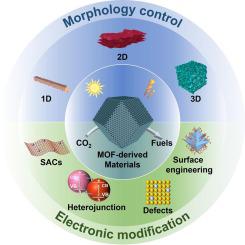当前位置:
X-MOL 学术
›
Coord. Chem. Rev.
›
论文详情
Our official English website, www.x-mol.net, welcomes your feedback! (Note: you will need to create a separate account there.)
Recent advances in metal–organic framework-derived materials for electrocatalytic and photocatalytic CO2 reduction
Coordination Chemistry Reviews ( IF 20.6 ) Pub Date : 2024-04-15 , DOI: 10.1016/j.ccr.2024.215858 Yu-Tao Zheng , Shumin Li , Ning-Yu Huang , Xinran Li , Qiang Xu
Coordination Chemistry Reviews ( IF 20.6 ) Pub Date : 2024-04-15 , DOI: 10.1016/j.ccr.2024.215858 Yu-Tao Zheng , Shumin Li , Ning-Yu Huang , Xinran Li , Qiang Xu

|
The extensive combustion of fossil fuels along with uncontrolled release of carbon dioxide (CO) has led to severe environmental contamination and global greenhouse effects. Carbon neutrality and low-carbon development are urgent demands for the enduring progress of human society. The utilization of electrocatalytic and photocatalytic reduction reaction to convert CO into valuable chemicals is viewed as a hopeful approach for addressing environmental issues and energy crises. Metal-organic frameworks (MOFs) are discovered to have extensive applications in the areas of electrocatalysis and photocatalysis because of their high porosity, versatile compositions and structural tunability. With the help of designed MOF structures and specific synthesis methods, it is convenient and targeted to regulate the morphologies and electronic structures of MOF-derived materials with higher stability, further affecting their catalytic performance towards CO reduction. In order to enhance catalytic performance to meet application requirements, it is essential to investigate the relationship between the morphologies, electronic structures of MOF-derived materials and their performances. In this review, to reveal the reaction mechanisms and provide theoretical support for catalyst design, the fundamentals of CO reduction through electrocatalytic and photocatalytic pathways are discussed. Subsequently, an overview of the developments in MOF-derived materials for electrocatalytic and photocatalytic CO reduction is presented, focusing on different optimization strategies such as morphology control and electronic modification. Finally, we outline the difficulties and opportunities for advancing MOF-derived materials in electrocatalytic and photocatalytic CO reduction, along with the strategies for developing electrocatalysts and photocatalysts with excellent performance.
中文翻译:

用于电催化和光催化二氧化碳还原的金属有机骨架衍生材料的最新进展
化石燃料的大量燃烧以及二氧化碳(CO)不受控制的释放导致了严重的环境污染和全球温室效应。碳中和、低碳发展是人类社会持久进步的迫切要求。利用电催化和光催化还原反应将二氧化碳转化为有价值的化学品被视为解决环境问题和能源危机的一种有希望的方法。金属有机骨架(MOF)由于其高孔隙率、多功能组成和结构可调性而在电催化和光催化领域具有广泛的应用。借助设计的MOF结构和特定的合成方法,可以方便、有针对性地调控具有更高稳定性的MOF衍生材料的形貌和电子结构,进一步影响其对CO还原的催化性能。为了提高催化性能以满足应用要求,有必要研究MOF衍生材料的形貌、电子结构及其性能之间的关系。在这篇综述中,为了揭示反应机理并为催化剂设计提供理论支持,讨论了通过电催化和光催化途径还原CO的基本原理。随后,概述了用于电催化和光催化 CO 还原的 MOF 衍生材料的发展,重点关注不同的优化策略,如形态控制和电子修饰。最后,我们概述了MOF衍生材料在电催化和光催化CO还原方面的困难和机遇,以及开发具有优异性能的电催化剂和光催化剂的策略。
更新日期:2024-04-15
中文翻译:

用于电催化和光催化二氧化碳还原的金属有机骨架衍生材料的最新进展
化石燃料的大量燃烧以及二氧化碳(CO)不受控制的释放导致了严重的环境污染和全球温室效应。碳中和、低碳发展是人类社会持久进步的迫切要求。利用电催化和光催化还原反应将二氧化碳转化为有价值的化学品被视为解决环境问题和能源危机的一种有希望的方法。金属有机骨架(MOF)由于其高孔隙率、多功能组成和结构可调性而在电催化和光催化领域具有广泛的应用。借助设计的MOF结构和特定的合成方法,可以方便、有针对性地调控具有更高稳定性的MOF衍生材料的形貌和电子结构,进一步影响其对CO还原的催化性能。为了提高催化性能以满足应用要求,有必要研究MOF衍生材料的形貌、电子结构及其性能之间的关系。在这篇综述中,为了揭示反应机理并为催化剂设计提供理论支持,讨论了通过电催化和光催化途径还原CO的基本原理。随后,概述了用于电催化和光催化 CO 还原的 MOF 衍生材料的发展,重点关注不同的优化策略,如形态控制和电子修饰。最后,我们概述了MOF衍生材料在电催化和光催化CO还原方面的困难和机遇,以及开发具有优异性能的电催化剂和光催化剂的策略。



























 京公网安备 11010802027423号
京公网安备 11010802027423号